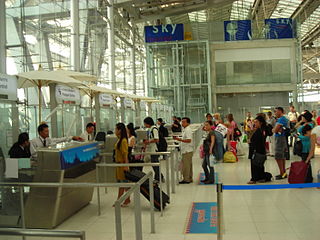A couple of days back, I wrote a blog post titled the story behind the “double world GDP” estimates. Yesterday, I chanced upon a blog post by Michael Clemens titled Do the Gains from International Migration “Go to the Immigrants”? (do read that — it makes a lot of points which I make in a slightly different way in this post). And reading that, I now think that some of what I said in my original blog post was, although not quite wrong, misleading.
GDP is roughly calculated by adding up the (price times quantity) of all final goods and services produced within a country’s domestic territory in a calendar year. World GDP is the sum of the GDPs of all nations. In the previous blog post, I tried to get into the story behind the double world GDP estimates. My overall statement was that the gain is seen largely through a direct effect in an increased value of production of the migrants themselves. This increase is not due to an increase in the skills of the migrants (though that might also eventually occur) but rather, is due to the place premium, whereby the exact same worker with the exact same skills produces more values, and gets paid more, in some places than others. That “more value” could be due to higher total factor productivity. Or it could simply be because the job the migrant does is more valued. For instance, a nanny in the United States may earn more than a nanny in India, because parents in the United States have more to gain by leaving their babies in a nanny’s hands and going to work instead.
On the other hand, a utilitarian or welfare-based analysis looks, not at price times quantity, but at the social surplus: difference between the reservation prices of buyer and seller, multiplied by (or rather, integrated over) the quantity. Graphically, it’s the area of a certain “triangle” between the demand and supply curves. Part of the social surplus is captured by the buyer, and part of it by the seller.
For any individual economic transaction, the social surplus can tell a very different story from the “GDP contribution” of that transaction (examples below). At a macro level, I think GDP offers a reasonable approximation to “utility” concepts, but it’s mathematically different.
Why is this relevant? As I said in my previous post, most of the GDP gain from migration is due to the increased value of production of the migrants — though there are also secondary occupational mix effects (see this paper by Dixon and Rimmer, for instance, or more general discussion at the suppression of wages of natives) where natives are relieved of some aspects of their jobs by immigrants and can switch to other jobs that create more value. However, even ignoring the occupational mix issue for the moment, the claim that the GDP gain is mostly registered to the migrant is quite different from the claim that the social surplus is largely captured by the migrant. Certainly, the claims are related, but they aren’t the same. I will make four points to clarify this.
- Consumer surplus: When Apple introduces a new iPhone, the gains in world GDP are registered to Apple and their suppliers, manufacturers, retailers, and employees. There may also be some compensating losses as other phone manufacturers lose out on buyers. However, the welfare gains are experienced not just by phone producers, but by phone consumers — aka all iPhone users. They’re the ones, after all, who are buying the phones, which means that they value the phone at least as much as Apple prices them. It’s the same story with migrant labor — the welfare gains go to the migrants, their employers, and all the customers of their employers who benefit from the employer’s ability to hire better or cheaper labor in the form of better quality or lower prices.
- Shifting of non-economic activities into the economic realm: This is a somewhat complicated point. The key idea is that part of the gain to world GDP will happen because non-economic activities return to the market. For instance, suppose I value my time spent cleaning up my apartment at $18. I value a clean apartment at $20, but the cheapest cleaning service costs $25. So, I choose to clean my apartment myself, getting a private surplus of $2, but there is no economic transaction. Now, suppose an immigrant arrives, who would be willing to clean my apartment for $11 or more. We negotiate and agree to a price of $14. The immigrant gets a surplus of $3, and my surplus is $6. My surplus has gone up by $4 (from an original of $2). But the GDP shows a gain of $14 corresponding to the shifting of the activity into the market realm.
A slight variant of this example — one where I value my own time spent cleaning the apartment more than $20 — would result in a situation where an apartment I would leave dirty getting cleaned up, so my social surplus went from zero (leaving the apartment dirty) to $6. In this variant, non-activity is replaced by activity. But in the original example, non-economic activity is being replaced by economic activity.
In both versions, though, we see that the GDP gain is much larger than the social surplus created. Does this mean that “double world GDP” estimates are gross overstatements? Not quite. Social surplus as a concept here makes sense for a single transaction with a fixed backdrop, and it’s not easy to generalize macroeconomically. Further, the “double world GDP” estimates are proportional estimates, and so even if you say that GDP vastly overstates social surplus, the overstatement is prima facie likely to be proportional. To actually provide an argument against, you’d need to show that the kind of gains to world GDP that would accrue from migration are not the kind that tend to increase social surplus that much in proportional terms.
- Occupational mix: Combining the occupational mix idea and the “cleaning my apartment” hypothetical: whether there are further increases in GDP depends on what I do with the time I’ve freed up by having somebody else clean the apartment. Do I use it for activity that would show up as economic production? Do I use it to consume more goods and services that would show up in somebody else’s production statistics? Or do I use it to just relax without producing or buying anything? In the first two cases, there will be a secondary effect of GDP gain from whatever activity I undertake instead of cleaning my apartment. In the third case, there is no secondary effect on GDP.
- Intra-family transfers: If the income of the parents in a family goes up, does that mean that the gains go “only to the parents” and not to the children in the family? Probably not. The increased parental income probably means gains for the children as well in material and other terms. The key here is intra-family transfers. Certainly, many parents are not completely altruistic regarding their children (though some are more than altruistic), so the extent of intra-family transfers can be debated, but the phenomenon does exist. The same argument can be made regarding cases where only one parent is earning an outside income — in this case, increases in this parent’s income are likely to improve the standard of living of everybody in the family, and the way in which the gains are distributed remains an empirical question. The analogous phenomenon in the context of migration is in terms of remittances. Note, however, that as far as the GDP gain is concerned, the gain is registered only to the person who actually works and/or migrates, not to the other family members who share in the benefits.
So the overall welfare analysis, as we’ve just seen, is a lot more complicated than the GDP contribution analysis. Again, even in a welfare analysis, I think it would still be true that “most of the gains go to the migrants” — though less sharply so than for a GDP contribution analysis. The benefits to migrants are at the heart of the utilitarian case for open borders. However, even after you take out “most” of a doubling of world GDP, there’s still a lot left in terms of benefits to immigrant-receiving countries, benefits to immigrant-sending countries, and global benefits.


